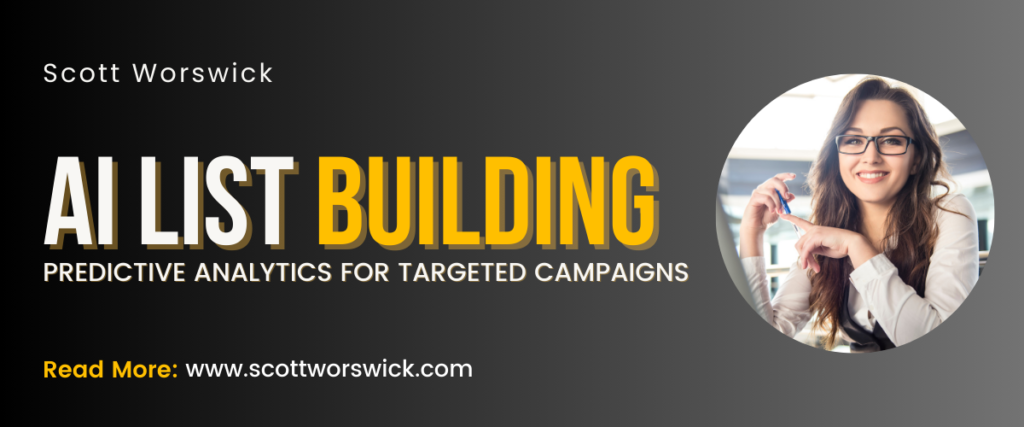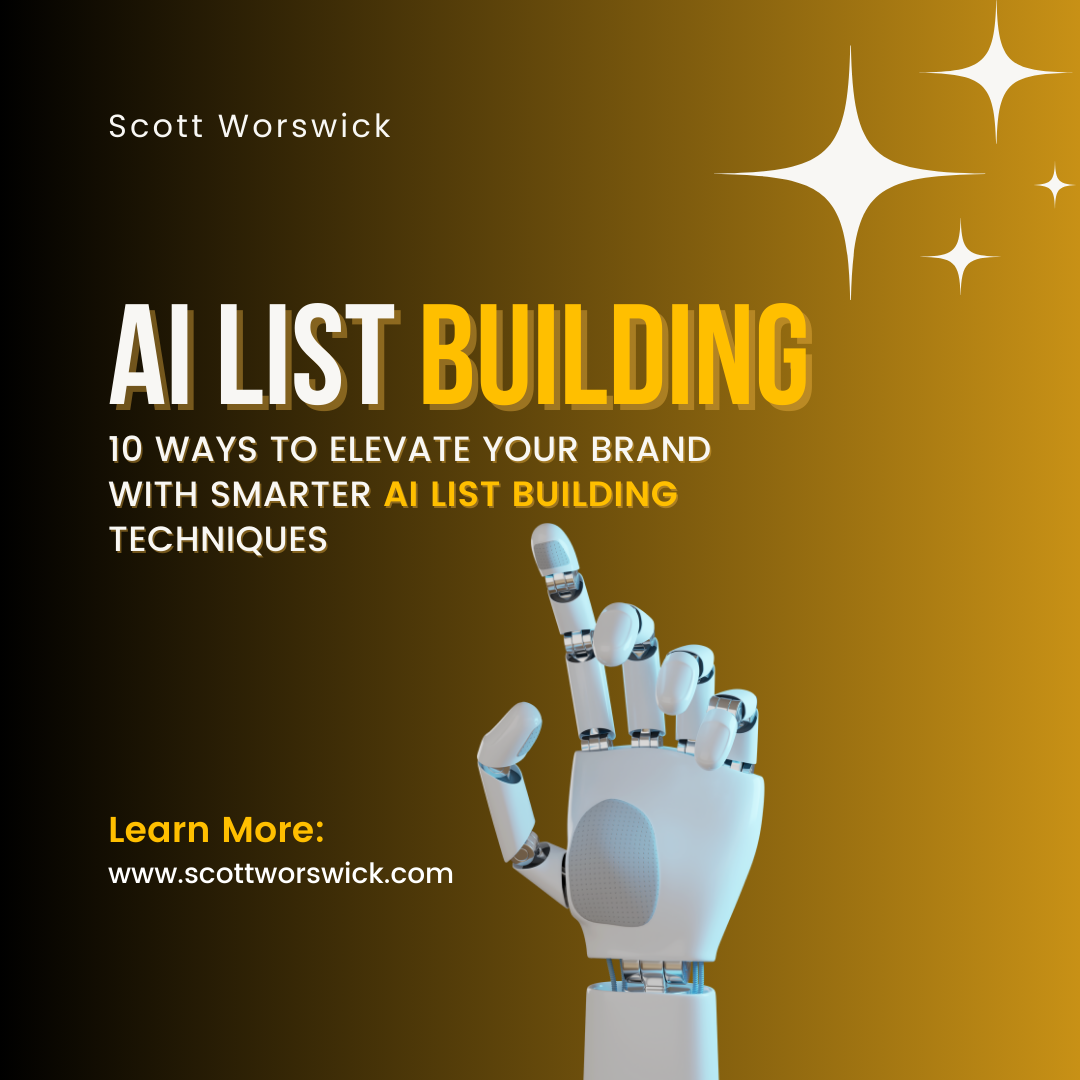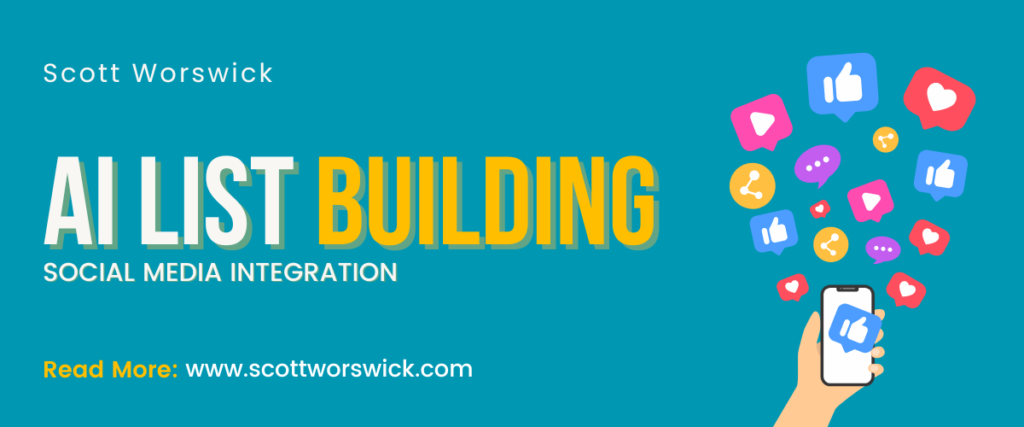In the modern era of digital marketing, the way brands connect with their audience is undergoing a profound transformation. Traditional list-building methods, while still in use, often fall short in efficiency and personalization. As businesses strive to engage with their audience more effectively, Artificial Intelligence (AI) emerges as a game-changer. Leveraging AI for list building can significantly elevate your brand by optimizing engagement, enhancing customer experiences, and driving higher conversion rates. The dynamic nature of AI allows for real-time data analysis and automation, making it an indispensable tool for modern marketers.
AI list building techniques offer a multitude of benefits that traditional methods simply cannot match. By utilizing AI, businesses can analyze vast amounts of data to uncover deep insights into customer behavior and preferences. This enables the creation of highly targeted and personalized marketing campaigns that resonate with individual customers. From predictive analytics to automated segmentation, AI empowers brands to refine their strategies with precision, ensuring that each marketing effort hits the mark. As a result, companies not only attract more subscribers but also maintain a more engaged and loyal customer base.
Moreover, the integration of AI list building streamlines and automates many time-consuming tasks. For instance, AI-driven chatbots can interact with website visitors in real-time, capturing essential customer information and converting visitors into subscribers effortlessly. Dynamic pop-ups powered by AI can appear at optimal moments, significantly boosting sign-up rates. Enhanced A/B testing ensures continuous optimization of email campaigns, making sure they are always at peak performance. These advanced capabilities of AI list building not only enhance operational efficiency but also free up valuable time for marketers to focus on strategic initiatives, ultimately driving brand growth and success.
Table of Contents
1. Personalized Content Recommendations by AI List Building
Personalized content recommendations stand at the forefront of AI list building techniques, transforming the way brands interact with their audiences. By leveraging sophisticated algorithms, AI analyzes customer behavior, purchase history, and browsing patterns to create tailored content that resonates with individual users. This level of personalization ensures that the content delivered to each subscriber is highly relevant, increasing engagement rates and fostering a deeper connection with the brand. When users receive content that speaks directly to their interests and needs, they are more likely to engage with emails, visit the website, and make purchases, thereby driving higher conversion rates and brand loyalty.
The magic of personalized content recommendations lies in AI’s ability to process and interpret vast amounts of data in real-time. This capability allows brands to adapt quickly to changing customer preferences and trends. For instance, if a customer frequently browses or buys a particular type of product, AI can automatically suggest similar items or complementary products in future email communications. This dynamic personalization not only enhances the customer experience but also increases the likelihood of repeat purchases. Moreover, by continuously learning from customer interactions, AI can refine its recommendations over time, making them increasingly accurate and effective.
Integrating personalized content recommendations into your AI list building strategy can also significantly reduce unsubscribe rates. When subscribers feel that the content they receive is tailored to their specific interests, they are less likely to opt-out of future communications. This not only helps maintain a robust email list but also ensures that your audience remains engaged and receptive to your marketing messages. Furthermore, personalized recommendations can drive traffic to other areas of your digital ecosystem, such as blog posts, social media channels, and special promotions, thereby creating a more holistic and interconnected brand experience. By harnessing the power of AI for personalized content recommendations, brands can achieve a higher level of customer satisfaction and drive sustained growth.
2. Predictive Analytics for Targeted Campaigns

Predictive analytics is revolutionizing the way brands execute targeted campaigns, making it a pivotal component of AI list building techniques. By utilizing historical data and advanced algorithms, predictive analytics forecasts future customer behavior with remarkable accuracy. This enables brands to design and implement highly targeted marketing campaigns that align with the predicted preferences and actions of their audience. For instance, if the data suggests that a segment of your audience is likely to be interested in a new product line based on their past purchases, you can tailor your email campaigns to highlight these products, thereby increasing engagement and conversion rates.
The power of predictive analytics lies in its ability to transform raw data into actionable insights. AI tools sift through vast amounts of customer data to identify patterns and trends that might not be immediately apparent. These insights can then inform various aspects of your marketing strategy, from the timing and frequency of emails to the specific content that is most likely to resonate with different segments of your audience. By leveraging predictive analytics, brands can move away from a one-size-fits-all approach and instead deliver highly personalized and timely messages that capture the attention of their subscribers. This level of precision not only enhances the effectiveness of your campaigns but also improves the overall customer experience.
Moreover, predictive analytics aids in optimizing resource allocation and maximizing ROI. By identifying which segments of your audience are most likely to respond to specific campaigns, you can allocate your marketing budget more efficiently. This targeted approach ensures that your resources are focused on high-potential leads, reducing wastage and increasing the overall efficiency of your marketing efforts. Additionally, predictive analytics can help in identifying potential churn risks, allowing you to proactively engage with at-risk customers and re-engage them with tailored offers or content. Incorporating predictive analytics into your AI list building strategy not only boosts the effectiveness of your campaigns but also fosters stronger, more personalized relationships with your audience, driving long-term brand loyalty and growth.
3. Intelligent Lead Scoring
Intelligent lead scoring is a game-changing component of AI list building techniques, enabling brands to prioritize and engage with the most promising prospects. Traditional lead scoring methods often rely on basic demographic information and manual assessments, which can be time-consuming and prone to error. In contrast, AI-driven lead scoring uses advanced algorithms and machine learning to evaluate leads based on a multitude of factors, including behavioral data, engagement history, and predictive analytics. This comprehensive approach ensures that your marketing and sales teams focus their efforts on leads with the highest potential for conversion, thereby optimizing resource allocation and increasing efficiency.
The power of intelligent lead scoring lies in its ability to continuously learn and adapt. As the AI system processes more data over time, it becomes increasingly accurate in predicting which leads are most likely to convert. For instance, if certain behaviors such as frequent website visits, specific content downloads, or interactions with particular emails are identified as strong indicators of a lead’s readiness to purchase, the AI system can automatically adjust the lead scores accordingly. This dynamic and data-driven approach ensures that your lead scoring model evolves with changing market conditions and customer behaviors, keeping your sales pipeline robust and up-to-date.
Furthermore, intelligent lead scoring enhances the alignment between marketing and sales teams, fostering a more cohesive and effective lead management process. By providing a clear and objective assessment of lead quality, AI-driven lead scoring eliminates much of the guesswork and subjectivity that can lead to miscommunication and inefficiencies. Sales teams receive high-quality leads that are ready for personalized outreach, while marketing teams can focus on nurturing leads that require more engagement. This synergy not only improves conversion rates but also enhances the overall customer experience, as leads are approached at the right time with the right message. Incorporating intelligent lead scoring into your AI list building strategy empowers your brand to engage with the right prospects more effectively, driving higher conversion rates and sustained business growth.
4. Automated Email Segmentation
Automated email segmentation is a cornerstone of effective AI list building techniques, revolutionizing how brands communicate with their audiences. By leveraging AI, businesses can automatically segment their email lists based on a wide range of criteria such as demographics, past behaviors, purchase history, and engagement levels. This granularity allows for the creation of highly personalized and targeted email campaigns that speak directly to the needs and interests of each segment. Instead of a one-size-fits-all approach, automated email segmentation ensures that each subscriber receives content that is relevant and timely, significantly boosting engagement and conversion rates.
The process of automated email segmentation begins with the collection and analysis of data. AI systems continuously gather information from various touchpoints, including website visits, social media interactions, email opens and clicks, and purchase behaviors. This data is then analyzed to identify distinct patterns and characteristics within the audience. For example, AI might identify a segment of users who frequently purchase tech gadgets and engage with related content. With this insight, you can craft specific email campaigns that highlight new tech products, special offers, or related content, tailored precisely to the interests of this segment.
Moreover, automated email segmentation is not a static process; it evolves with your audience. As subscribers’ behaviors and preferences change, AI systems can dynamically update segments to reflect these changes. This ensures that your email marketing efforts remain relevant and effective over time. For instance, if a customer who was initially interested in tech gadgets starts showing interest in home automation products, the AI system can reassign them to a different segment and adjust the email content accordingly. This level of responsiveness helps maintain high engagement rates and reduces the likelihood of subscribers opting out due to irrelevant content.
Incorporating automated email segmentation into your AI list building strategy also enhances the efficiency of your marketing operations. Manual segmentation is often labor-intensive and prone to errors, but AI automates this process, saving valuable time and resources. Marketers can then focus on crafting creative and compelling content rather than getting bogged down in data analysis and list management. Additionally, by delivering more personalized and relevant emails, automated segmentation can improve customer satisfaction and loyalty, leading to higher lifetime value. This strategic approach not only drives immediate results but also builds a stronger, more engaged customer base for long-term brand growth.
5. Chatbots for Real-Time Engagement
Chatbots for real-time engagement are a revolutionary aspect of AI list building techniques, providing brands with an innovative way to interact with their audience. By deploying AI-powered chatbots on your website or social media platforms, you can engage visitors instantly, answering their queries, providing information, and guiding them through the sales funnel. This immediate, personalized interaction not only enhances the user experience but also captures valuable data about potential customers. Chatbots can ask for email addresses during these interactions, seamlessly growing your email list without disrupting the user journey.
The strength of chatbots lies in their ability to operate 24/7, ensuring that customer inquiries are addressed promptly regardless of time zones or business hours. This constant availability can significantly improve customer satisfaction and trust. For instance, a visitor who receives instant support late at night is more likely to have a positive impression of your brand. Moreover, chatbots can handle multiple conversations simultaneously, ensuring that no potential lead is missed. This scalability is crucial for brands looking to expand their reach and build a robust email list efficiently.
AI-driven chatbots are also adept at personalizing interactions based on user data. By analyzing past behavior, purchase history, and preferences, chatbots can tailor their responses to meet the specific needs of each visitor. For example, if a returning customer is browsing a particular product category, the chatbot can recommend related products, provide personalized discounts, or share relevant content. This level of personalization not only enhances the customer experience but also increases the likelihood of capturing the visitor’s email for further engagement. The data collected through these interactions can be used to refine future marketing strategies, ensuring that your AI list building efforts are continuously optimized.
In addition to driving immediate engagement and list growth, chatbots also provide valuable insights into customer behavior and preferences. The data collected from chatbot interactions can be analyzed to identify common questions, concerns, and interests among your audience. This information can inform your overall marketing strategy, helping you create more targeted and effective campaigns. For example, if a significant number of visitors inquire about a specific product feature, you can highlight this feature in your email campaigns or create dedicated content around it. By integrating chatbots into your AI list building strategy, you can not only enhance real-time engagement but also build a more comprehensive understanding of your audience, driving long-term brand growth and customer loyalty.
6. Dynamic Pop-Ups
Dynamic pop-ups are a powerful tool in the realm of AI list building techniques, offering a highly effective way to capture the attention of website visitors and convert them into subscribers. Unlike traditional static pop-ups, dynamic pop-ups leverage AI to analyze visitor behavior in real-time, determining the optimal moment to display a sign-up form. By tailoring the timing and content of pop-ups to each individual user’s actions and preferences, brands can significantly increase the likelihood of conversion. For example, a dynamic pop-up might appear just as a user is about to exit the site, offering a compelling incentive to stay connected, such as a discount code or exclusive content.
The personalization capabilities of dynamic pop-ups extend beyond just timing. AI can customize the content of the pop-up based on the visitor’s browsing history, demographics, and past interactions with the brand. This means that a returning visitor who has shown interest in a particular product category can be presented with a pop-up highlighting related products or offering a targeted promotion. This level of personalization makes the interaction feel more relevant and valuable to the user, enhancing their overall experience and increasing the chances of them subscribing to your email list. Furthermore, by continuously learning from visitor interactions, AI systems can refine and improve the effectiveness of pop-ups over time, ensuring that your list-building efforts remain efficient and effective.
Integrating dynamic pop-ups into your AI list building strategy not only boosts subscriber rates but also enhances the overall user experience on your website. Because these pop-ups are contextually relevant and strategically timed, they are less likely to be perceived as intrusive or annoying, compared to generic pop-ups that appear at random. This respectful approach to visitor engagement helps maintain a positive perception of your brand while still driving conversions. Moreover, the data collected through these interactions can provide valuable insights into visitor behavior and preferences, further informing your marketing strategies. By leveraging dynamic pop-ups, brands can create a more engaging, personalized, and effective pathway to building a robust email list, driving both immediate and long-term business growth.
7. Enhanced A/B Testing
Enhanced A/B testing, powered by AI, is a transformative element of modern AI list building techniques, allowing brands to optimize their marketing strategies with unprecedented precision. Traditional A/B testing involves creating two versions of an email or landing page to see which performs better, but this process can be slow and limited by human analysis. AI enhances A/B testing by rapidly analyzing large datasets and identifying subtle patterns that might go unnoticed by human marketers. By continuously learning from each test, AI can provide insights into which elements—such as subject lines, images, and calls-to-action—resonate most with different audience segments, leading to more effective and targeted email campaigns.
One of the key advantages of AI-enhanced A/B testing is its ability to handle multiple variables simultaneously. While traditional A/B tests often focus on a single element, AI can manage multivariate tests that examine several factors at once, such as different headlines, body content, and visual elements. This comprehensive approach accelerates the optimization process, allowing brands to fine-tune their campaigns more quickly and accurately. For example, AI can test various combinations of content and design to determine the optimal mix that drives the highest engagement rates. As a result, brands can swiftly adapt their strategies to meet the evolving preferences of their audience, ensuring that each campaign is as effective as possible.
AI list building enhances A/B testing and contributes to more personalized and dynamic email marketing. By continuously analyzing the performance of different campaign elements, AI can segment audiences more precisely and tailor content to individual preferences. This means that instead of sending a generic email to your entire list, you can deliver highly personalized messages that are more likely to resonate with each recipient. For instance, AI might reveal that a particular segment of your audience responds better to emails with a humorous tone, while another segment prefers a more formal approach. By incorporating these insights into your AI list building strategy, you can create more engaging and relevant communications, ultimately driving higher conversion rates and fostering deeper customer loyalty.
8. Social Media Integration
Social media integration represents a potent avenue for brands to enhance their AI list building strategies, forging deeper connections with their audience and expanding their reach across digital platforms. By integrating AI into social media marketing efforts, brands can leverage sophisticated algorithms to analyze user interactions and identify potential leads. AI can sift through vast amounts of social media data to pinpoint individuals who exhibit behaviors indicative of interest in the brand’s products or services. For example, AI might identify users who frequently engage with the brand’s posts, share content, or comment on related topics, signaling a higher likelihood of conversion.
Moreover, AI-driven social media integration enables brands to deliver highly targeted and personalized campaigns that resonate with their audience. By analyzing user data, AI can segment social media audiences based on demographics, interests, and behaviors, allowing brands to tailor their messaging and content accordingly. This level of personalization enhances the relevance and effectiveness of social media campaigns, driving higher engagement and conversion rates. For instance, AI might identify a segment of users who have shown interest in a particular product category and deliver targeted ads showcasing relevant products or promotions, enticing them to join the brand’s email list.
Furthermore, social media integration with AI list building techniques facilitates seamless cross-platform engagement, allowing brands to connect with their audience across multiple touchpoints. AI can analyze user interactions across different social media platforms to create a unified view of each individual’s preferences and behaviors. This holistic understanding enables brands to deliver consistent messaging and experiences across social media channels, reinforcing brand identity and fostering deeper connections with their audience. By harnessing the power of AI for social media integration, brands can elevate their list building efforts, expand their reach, and cultivate a loyal customer base in the digital landscape.
9. Advanced Data Cleaning
Advanced data cleaning emerges as a cornerstone of effective AI list building techniques, ensuring that brands maintain a high-quality email list and maximize the impact of their marketing efforts. As data volumes continue to grow exponentially, the need for accurate and reliable data becomes paramount. AI-powered data cleaning tools leverage sophisticated algorithms to automatically identify and rectify inaccuracies, inconsistencies, and duplicates within the email list. By streamlining this process, brands can ensure that their email communications reach the intended recipients and deliver value to their audience.
Furthermore, advanced data cleaning with AI list building techniques enables brands to enhance segmentation and personalization efforts. Clean and accurate data serves as the foundation for effective audience segmentation, allowing brands to divide their email list into distinct groups based on demographics, behaviors, and preferences. This granularity enables marketers to deliver highly targeted and personalized content that resonates with each segment, driving higher engagement and conversion rates. For instance, AI can identify inactive subscribers or those with outdated contact information and take proactive measures to re-engage or update their details, ensuring that the email list remains up-to-date and responsive.
Moreover, advanced data cleaning contributes to improved deliverability and sender reputation, crucial factors in the success of email marketing campaigns. By removing invalid email addresses and minimizing bounces, AI list building techniques help brands maintain a positive sender reputation with email service providers. This, in turn, increases the likelihood that emails will reach subscribers’ inboxes rather than being flagged as spam or undeliverable. As a result, brands can achieve higher open and click-through rates, ultimately driving greater ROI from their email marketing efforts. By incorporating advanced data cleaning into their AI list building strategy, brands can optimize the effectiveness of their email campaigns and cultivate stronger relationships with their audience.
10. Behavioral Trigger Emails
Behavioral trigger emails represent a potent strategy within the realm of AI list building techniques, allowing brands to deliver timely and relevant communications that resonate with individual subscribers. By leveraging AI algorithms to analyze user behavior and interactions, brands can identify specific triggers that prompt automated email responses. These triggers could include actions such as abandoning a shopping cart, browsing specific products, or signing up for a webinar. By sending targeted emails based on these behaviors, brands can re-engage subscribers at critical moments in the customer journey, increasing the likelihood of conversion and fostering stronger relationships.
Moreover, behavioral trigger emails enable brands to deliver personalized and contextualized messages that cater to the unique needs and interests of each subscriber. AI-powered algorithms can analyze a subscriber’s past interactions, purchase history, and preferences to tailor the content and timing of trigger emails accordingly. For example, if a subscriber abandons their shopping cart, AI can send a follow-up email reminding them of the items left behind and offering an incentive to complete the purchase, such as a discount or free shipping. This personalized approach not only increases the chances of converting the abandoned cart into a sale but also enhances the overall customer experience.
Furthermore, behavioral trigger emails with AI list building techniques facilitate automation and scalability in email marketing efforts. Once the trigger conditions are set, the email automation system can execute the sending of relevant emails automatically, without requiring manual intervention from marketers. This allows brands to deliver timely communications to subscribers at scale, even as their email list grows. By harnessing the power of AI for behavioral trigger emails, brands can streamline their email marketing workflows, increase efficiency, and drive higher engagement and conversion rates, ultimately elevating their brand in the digital landscape.
Conclusion
The integration of smart AI list building techniques offers brands an unparalleled opportunity to elevate their marketing strategies and foster meaningful connections with their audience. By harnessing the power of AI-driven tools and algorithms, brands can optimize every aspect of their list building efforts, from personalized content recommendations to dynamic pop-ups and behavioral trigger emails. These techniques enable brands to deliver highly targeted and relevant content to their subscribers, increasing engagement, and driving conversions. Moreover, AI-powered data cleaning and segmentation enhance the accuracy and effectiveness of email campaigns, ensuring that brands maintain a high-quality email list and deliver value to their audience.
Furthermore, AI list building techniques facilitate automation and scalability in marketing operations, allowing brands to streamline workflows and allocate resources more efficiently. From automated email segmentation to predictive analytics for targeted campaigns, AI empowers brands to optimize their strategies with precision and agility. By leveraging AI, brands can adapt to changing market dynamics and customer preferences more effectively, driving sustained growth and success in the digital landscape.
In the competitive landscape of digital marketing, embracing smart AI list building techniques is no longer an option but a necessity for brands looking to stay ahead of the curve. By implementing these strategies, brands can create more personalized, engaging, and effective marketing campaigns that resonate with their audience. As AI continues to evolve and advance, brands must remain agile and innovative in their approach to list building, leveraging the power of AI to forge stronger connections, drive conversions, and ultimately elevate their brand in the eyes of their customers.






Pingback: How AI List Building Drives Engagement and Conversions -